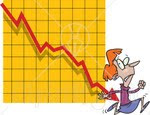 The recent sharp pullback in the markets caused a few readers to email me with more sell stop questions. Most were discussed in my e-book, but some need clarification. Reader Andy had this to say:
The recent sharp pullback in the markets caused a few readers to email me with more sell stop questions. Most were discussed in my e-book, but some need clarification. Reader Andy had this to say:
I followed your stop loss strategy and my Trailing Stop Losses were triggered last week while I was out of town (Maui!). This leads me to two questions. I’m sure you have commented on them before, so I’d really appreciate a reference to an archived blog if you have one…
1. I noticed you said,
“Needless to say I held off liquidating some our positions whose sell stops were triggered Friday. The next few trading days should shed some more light on whether this was just a relief rally or if the major up trend will resume its course again.”
My follow up is why? I don’t consider this needless to say. For a system based on averages and trend lines, I’m curious why you don’t follow “the letter of the law” and sell when a trigger says to. Unfortunately, my stop losses were triggered while I was away and I didn’t get the benefit of the slight rebound on Monday.
2. I’ve read over and over again your stop loss strategy, which I followed. However, I don’t recall reading is the justification on waiting until the ETF has reached the high (while one owned it) before you buy back in. How was this strategy established? For example, if I held an ETF that reached 100, then dropped and triggered a sell at 93, why wait until it reaches 100 to buy back in? I’m just curious why this is chosen as the buy-back point.
a. What if a stock never reaches that previous high? Do you establish a new (false) “high” after a certain amount of time? Let’s say I followed this strategy in 1999 and had several sells trigger prior to the drop. If these highs from 1999 have not been reached as of now (2010), would you have reassessed what your buy-back price should be? For example, if the high has not been reached for 5 years, would you take the previous X years as a new baseline and use the high during that time as your buy-back point. Hopefully, this question makes sense.
To your points:
1. The idea behind the use of sell stops is to get out of the market before disaster strikes and wreaks havoc with your portfolio. At the same time, the danger of participating in a whip-saw signal always lurks, meaning that a sell can be followed by a buy quickly as the markets turn around and head higher again.
Whenever possible, we like to avoid that situation as discussed in Subjective Reasoning.
For example, if my sell stop got triggered based on last night’s closing price, I prepare myself to enter the order this morning, unless a huge rebound is in the making. If that happens, I will hold off selling until it becomes clear again that my stop levels have been violated. This may take a day or two, but more often than not, a whip-saw will have been avoided.
2. You want to be sure that you don’t get caught in a downdraft twice. This week was a very good example as Monday’s rebound along with Wednesday’s higher close could have gotten you back in based on thinking that happy days are here again. Thursday, the markets retreated sharply and Friday, as I am writing this, we headed for a much lower close, unless a last hour rebound saves the day.
I have found that the more conservative way is to wait with re-entering until the old highs, which served as a basis for calculating your sell stop, have been taken out. This is a case where you’re better off to be a little late than too early, especially, this far into the buy cycle, where we are very likely closer to a top than to a bottom.
a. You totally missed the point here. Re-entering as discussed above refers only to the current sell stop. Say, the markets head further south, and we break below the long term trend line, all old highs no longer matter, and we start all over. That simply means, we re-enter the market and move back into equities when the Domestic and International TTIs (Trend Tracking Indexes) break back above their long-term trend lines.
Trend Tracking attempts as much as possible to let you make unemotional investment decisions. However, at major inflection points, when market direction reverses, you need to step in and make sure your sell stops are executed wisely.
Not having any human interaction at all, can lead to chaos as we saw last week when the Dow dropped almost 1,000 points intra-day, because a bunch of unsupervised computer programs played ping pong with buy and sell orders.
